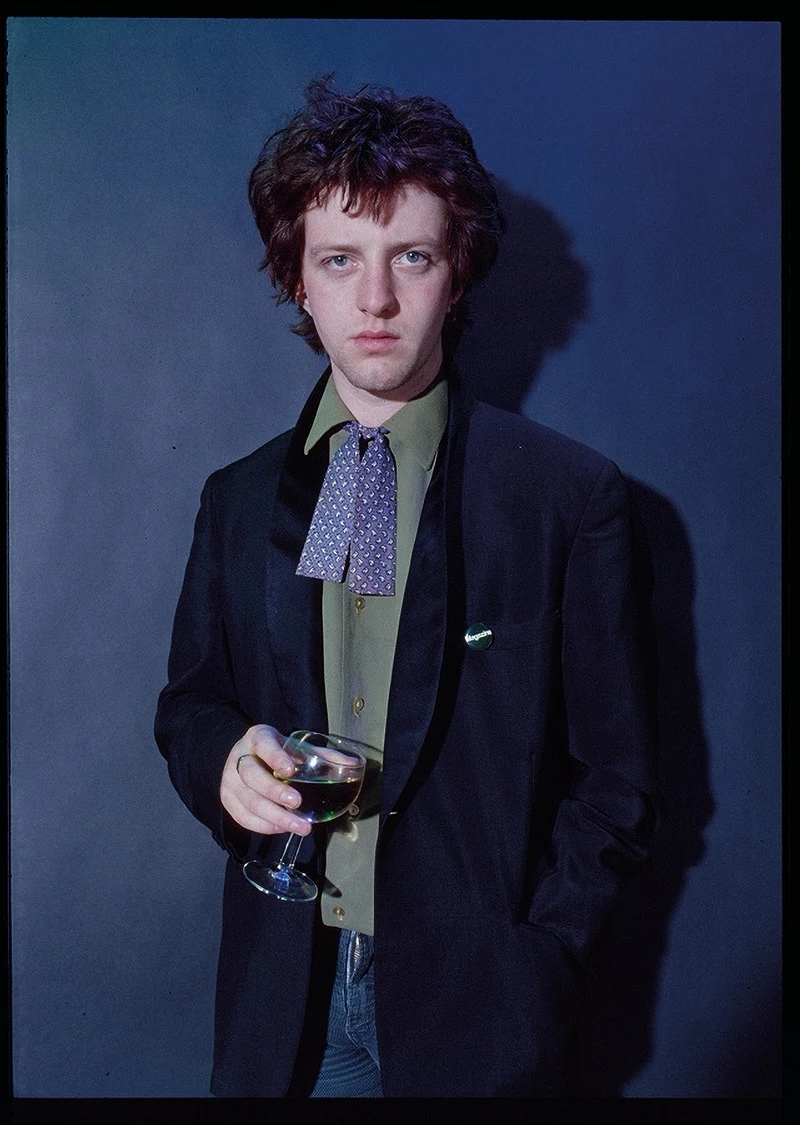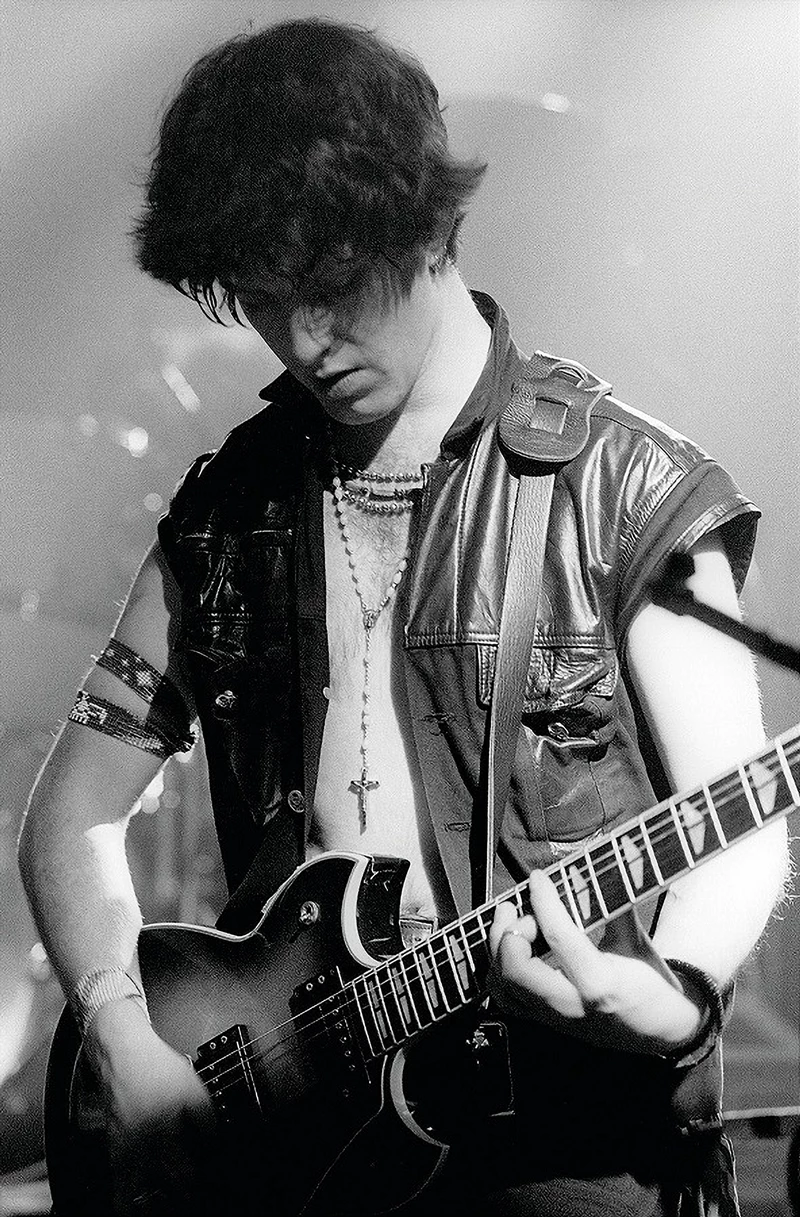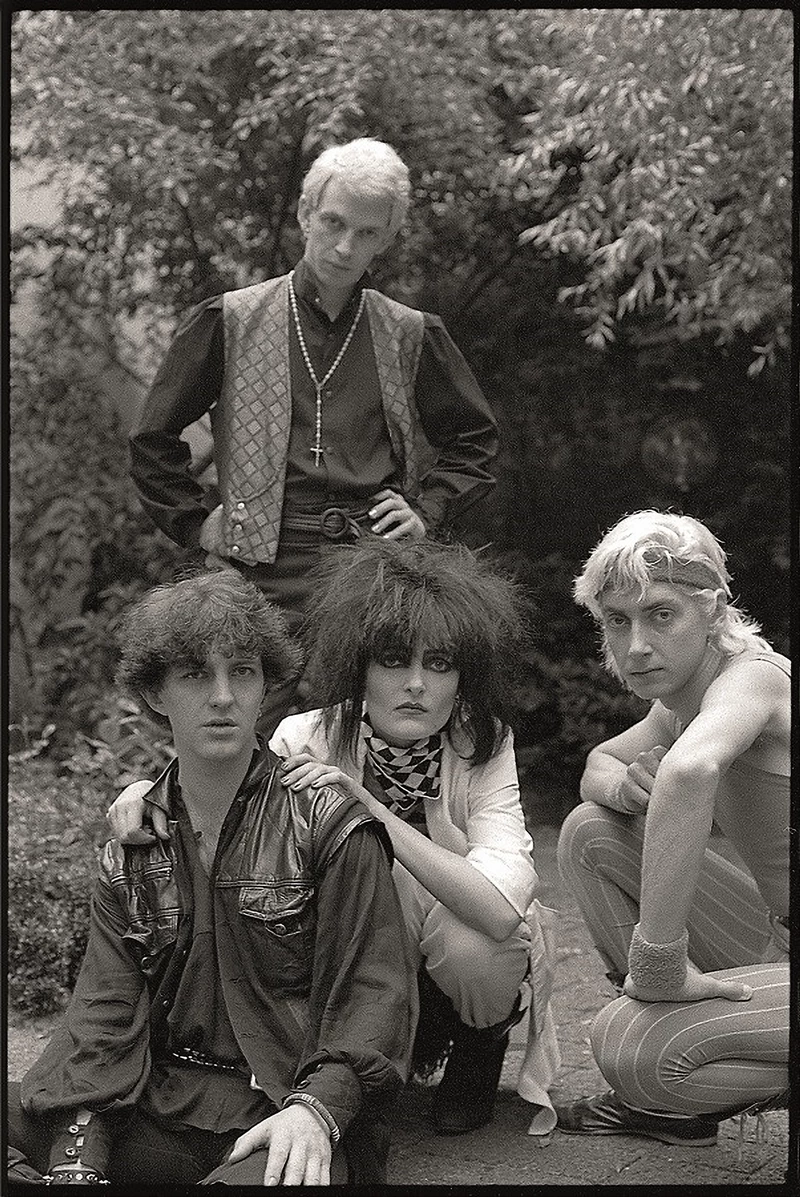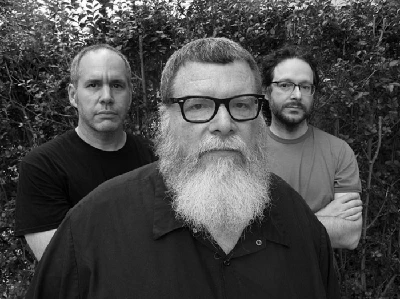Nicola Black - Interview
by Andrew Twambley
published: 19 / 1 / 2024

intro
Film producer Nicola Black speaks to Andrew Twambley about her new project, ‘The Light Pours Out Of Me. an in-depth film about the life of guitarist John McGeoch,
What do the following bands have in common, Magazine, Siouxsie and The Banshees and PIL?. Okay, they are probably the best post punk bands that ever existed…. but the answer I am looking for is: John McGeoch, the highly individual, recognisable and sensationally creative guitar player who stamped his identity on those bands and their music across the late 1970s to the early 1990s. The great Johnny Marr said that “having John in your band was like signing George Best for your soccer team.” John McGeogh was never a front man and never hogged the limelight….he just wanted to create. Those in the business recognised his genius… but now a film is in the process of being put together in order to celebrate his art with everyone. We spoke to the film’s producer, Nicola Black. PB: We are here to discuss the documentary you are in the process of producing, ‘The Light Pours Out of Me’ about the hugely talented guitarist John McGeoch, who sadly passed away in 2004. So, how did you become involved in John’s story? I ask because you don’t look old enough to have been there first time around. NB: (Laughs) That is kind of you to say so. I suppose I am just very into music eclectically, listening to all types of music and going to a lot of gigs. Music is an important part of my life. I was a total Bowie nerd and there was something about the Banshees that caught my attention, a combination of Siouxsie’s amazing presence and well-conceived intelligence with a really interesting sound which was quite different. Then going forward a number of years. somebody introduced me to Magazine and I was just blown away by their music, with the obvious examples of ‘Shot By Both Sides’ and “The Light Pours Out of Me”. I was, at the time working with Barry Adamson (Magazine bassist – Ed()as I was interested in doing a joint project with him, and he got me further into Magazine. Barry made me realise the connection between the two bands, being guitarist John McGeoch, who was a fellow Scot. I noticed that there was little out there about John apart from a Wikipedia page and I thought, as a film maker, what an interesting documentary it would make. Fast forward again to 2022, when the book ‘The Light Pours Out of Me’ by Rory Sullivan-Burke came out and blew me away! It was a gift of a book, and so fantastically well-researched and thoughtfully put together, being both sensitive and enlightening and I thought that as the book now existed that I could make the film. I contacted Rory and John’s family, and they were all happy for us to produce a documentary which would be sensitive to John’s legacy and would emphasise his contribution to music, a subject that, before the book, had been sadly neglected PB: So, you were a big Siouxsie fan and some years later you got into Magazine. Did you immediately appreciate the guitar connection? NB: I could immediately recognise the similarities quite clearly. Both bands were full of superb individual musicians that gelled into solid teams. PB: Magazine produced three of the finest albums of the post-punk era, ‘Real Life’, ‘Secondhand Daylight’ and ‘The Correct Use of Soap’, and. although the albums became less popular as they went on, they became better with each album with ‘The Correct Use of Soap’ being a masterpiece, but sadly largely overlooked. NB: Yea, the tracks on that are absolutely astonishing. PB: I recall about ten years ago there was a documentary or a long radio show about John, which I think was on the BBC. NB: Yes, it was on BBC radio. PB: Were you aware of that at the time or did you hear it when researching for the documentary? NB: I only heard it recently while I was preparing for the documentary. The great thing about my research was that I had full co-operation of the family, so I had access to the family archive, and they were generous in letting me have handicam footage of John with his daughter Emily as a baby and as a young child. He was obviously very close to his daughter. I also have ten rolls of Super 8 footage sitting here waiting for me to go through. I have no idea what’s in them. They could be a goldmine. Then there are photos, recordings and all manner of stuff. PB: Now, I know John was a Scot, but to me he was a famous Mancurian. He was at Manchester Polytechnic in the mid-1970s, leaving a year after I went to the Polytechnic. So, I was aware of him in those days. As I recall it, he didn’t really get involved in the raucous student life as he was too into his art and music. I am not sure how he ran into Howard Devoto. Do you know? NB: Howard had just written ‘Shot By Both Sides’ and was looking for collaborators for the band. John was living with a guy called Malcolm Garrett who knew Howard. They met at a student party and John agreed to audition. Howard appreciated the elegance of John’s playing…. and the rest is history, as they say. PB: When I listen to ‘Real Life’ today it just doesn’t seem like an album which is forty-five years old. The distinctive guitar playing lifts every track. One could recognise John’s work whatever he did. I am no guitar expert, but even I could appreciate the majesty of his art. NB: You are absolutely right. I know exactly what you mean. Others who are more knowledgeable about guitars say that he was extremely creative and could master incredibly complex music. All his efforts went into the song.``````````````````````````` He was never guilty of grandstanding, and he was fortunate to work with other musicians throughout his career who were also supremely creative. The sounds he created were unique. He used a really unique flanger, which normally is a foot pedal but he adapted his and fixed it by the mic so he could have far more control. It gave him an almost psychedelic sound , when he wanted it. He could kind of bend the sound. When he played with keyboard player Dave Formula in Magazine, you often couldn’t distinguish the guitar from the keyboard. PB: I think Siouxsie once said to him that she wanted a sound like a horse falling off a cliff…and he immediately produced such a sound, NB: Yes, there are some arrangements with cello and violin and it’s impossible to distinguish which is which. Where each instrument begins and ends is really difficult to tell. PB : In the past 18 months or so I have interviewed two musicians, who unprompted extolled the great virtues of John, and they were Richard Jobson and Rusty Egan. Both explained how he created his masterwork halfway back on the stage without the need to jump around saying. “Look at me.” NB: As a filmmaker, it can be so frustrating because I have looked at so much archive and John very often performed in the shadows. You had Siouxsie and Severin up front in the limelight and the same with Magazine. Even when John had a solo, the camera would be on Barry. I think John was happy to do his thing without drawing attention. PB: John was in, by accident, co-incidence or on purpose, three of the very greatest post punk bands. How did he manage that? NB: I am second guessing here, because we can’t ask him, but he was aware of his talent and what he could contribute and he wanted to be involved in the most creative bands of the time that were compatible with they type of music he wanted to generate. At the end of his spell with Magazine, they were not achieving the accolades he wanted, and an opportunity came in the form of The Banshees and that’s something he could not turn his back on. And later PIL turned up and that was a great fit. What I should point out is that the three bands had extraordinarily charismatic lead singers and I wonder if he was drawn to the power and magnetism of those singers, being artists he wanted to align himself with. The downside of working with such strong personalities must be the difficulty in carving out your own identity….so maybe he felt somewhat marginalised which could have led to John’s eventual downfall. PB: What happened at the end of his term with the Banshees? NB: Well, John did have his demons . He was going through a very bad patch at the end of his time with the Banshees, and there was the Madrid incident. I believe he was having a mini-breakdown and said he needed help. He was given half a Valium by the manager, which was the wrong thing to do and the band were not happy with his performance. He left the band in the aftermath. I think the Banshees would admit now that mental health issues were not matters given enough consideration. But you have to remember that saying that you were struggling mentally was thought of as a sign of weakness in the 1980s. Management just said, “This isn’t working. Let’s move on.” The idea of masculinity at the time is something we explore in the film. John was very attached to his daughter Emily and found touring quite difficult. He wanted to make his music but also wanted to be at home with his family. Especially with PIL he was away a lot and they spent months on end in America. The family came over now and again, but that was not enough for John. He did have a dark side, which was sadly misunderstood. PB: How do you deal with the mental health side of John’s life in the documentary? NB: The book was really, really important. The author, Rory Sullivan-Burke, is an associate director of the film as we wanted to maintain the tone of the book. The book is not salacious. It talks of addiction in a way that supports John’s legacy and that is what we want to do, with the support of the family. In fact, our film is told from the point of view of Emily. The family have been involved from the outset. PB: Finally, where are we up to with the film? NB: Well, we have launched a Kickstarter.com campaign which is live, and I would really appreciate you giving your readers a big word on this as it is really important for us to get to the next stage. It is very difficult to make this sort of film due to the amount of archive we need and all the music clearances required. It is still quite a big ask…we have made significant progress but there is still a great deal to do. We have a long way to go, but if things go well and we receive the funding , it should take about 18 months to complete. There is lots of great memorabilia on the page which should go along way in the quest for funding. PB: Thank you. More information about the Kickstarter campaign can be found at https://www.kickstarter.com/projects/invisiblebritain/john-mcgeoch-the-light-pours-out-of-me
Band Links:-
https://en.wikipedia.org/wiki/John_McGeochPlay in YouTube:-
Picture Gallery:-


most viewed articles
current edition
Carl Ewens - David Bowie 1964 to 1982 On Track: Every Album, Every SongArmory Show - Interview with Richard Jobson
John McKay - Interview
Colin Blunstone - Thalia Hall, Chicago, 16/7/2025
Bathers - Photoscapes 1
Billie Eilish - O2 Arena, London, 10/7/2025
Loft - Interview
Visor Fest - Valencia, Spain, 26/9/2025...27/9/2025
Sir Tim Rice - Interview
Robert Forster - Interview
previous editions
Manic Street Preachers - (Gig of a Lifetime) Millennium Stadium, Cardiff, December 1999Heavenly - P.U.N.K. Girl EP
Beautiful South - Ten Songs That Made Me Love...
Peter Perrett - In Dreams Begin Responsibilities Interview Part One
Boomtown Rats - Ten Songs That Made Me Love....
Oasis - Oasis, Earl's Court, London, 1995
Coldplay - Wembley Arena. London, 16/8/2022
Trudie Myerscough-Harris - Interview
Prolapse - Interview
Pixies - Ten Songs That Made Me Love...
most viewed reviews
current edition
Davey Woodward - Mumbo in the JumboSick Man of Europe - The Sick Man of Europe
Lucy Spraggan - Other Sides of the Moon
Amy Macdonald - Is This What You've Been Waiting For?
Phew, Erika Kobayashi,, Dieter Moebius - Radium Girls
Suzanne Vega - Flying With Angels
Bush - I Beat Loneliness
Alice Cooper - The Revenge of Alice Cooper
Blueboy - 2
Cynthia Erivo - I Forgive You
related articles |
|
Willard Grant Conspiracy/Big Hogg: Feature (2015 |

|
| We profile our next Pennyblackmusic Bands Nights which will feature the Willard Grant Conspiracy and Big Hogg at the Glad Cafe in Glasgow on Thursday 10th September and the Wee Red Bar in Edinburgh on Friday 11th September |
Pennyblackmusic Regular Contributors
Adrian Janes
Amanda J. Window
Andrew Twambley
Anthony Dhanendran
Benjamin Howarth
Cila Warncke
Daniel Cressey
Darren Aston
Dastardly
Dave Goodwin
Denzil Watson
Dominic B. Simpson
Eoghan Lyng
Fiona Hutchings
Harry Sherriff
Helen Tipping
Jamie Rowland
John Clarkson
Julie Cruickshank
Kimberly Bright
Lisa Torem
Maarten Schiethart